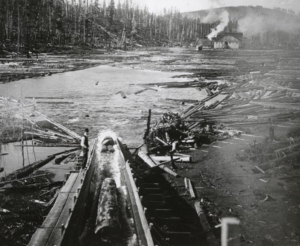Forests

Log flume and pond at Dee Mill (Hood River County History Museum)
Forests dominate the landscape of the Hood River Watershed. Today, approximately 75 percent of the Watershed is forested, of which 66 percent is on Mt. Hood National Forest, 21 percent is Hood River County Forest, and 13 percent is private industrial timberland. Historically, forests covered most of the Watershed with some open areas from forest fires or wetlands. When the first European settlers arrived in the mid-1800s they began felling trees almost immediately. The first saw mill was built on Neal Creek in 1861 near where Dethman Ridge Road crosses today. This was followed by others on the East Fork Hood River and Green Point Creek. Logs were transported to these mills by river channels or flumes, horse teams, and later railroads. Transport by river channel involved temporarily damming a creek, staging logs behind the dam, and then breaking the dam to move the logs downstream with the surge of backed up water. Called “splash-damming”, this practice scoured out stream channels and destroyed existing fish habitat.
The composition of forests in the Watershed varies considerably. At the higher elevations on the north slopes of Mt. Hood, much of the forest is rebounding from extensive wildfires that burned in recent decades. Mature stands at higher elevations are dominated by a mix of mountain hemlock, silver fir, noble fir, larch, western red cedar, and western hemlock. Douglas-fir is the dominant tree species from mid-elevations to the valley floor. Ponderosa pine is also prevalent in this range, particularly on the drier east side. Oak woodlands and savannas are found at lower elevations, although their extent has declined due to fire suppression and encroachment by conifers. Two significant areas of oak woodland in the Watershed are found at Middle Mountain and on the eastern edge of the Watershed around Surveyor’s Ridge, Whiskey Creek, and Neal Creek.
Forests help regulate precipitation, evaporation, and streamflow. Depending on localized stand structure, forests can influence the amount of snowfall that reaches the ground as well as when and how the snowpack dissipates. Forests also help reduce the impacts of storms by slowing runoff and reducing flooding. Healthy forests anchor the soil, filtering out pollutants, limiting erosion, and shading streams. Finally, large trees growing near streams are a crucial source of instream wood, which is the foundation of instream habitat for salmon and steelhead.
Farms

Nathanial Coe brought the first fruit trees to the Hood River Valley in 1854 and he and his family were the first settlers to remain here. Other settlers quickly followed, clearing the rich, level ground around Parkdale and Dee and sending the timber to local sawmills. By 1876, the Water Supply Company of Hood River started to dig irrigation ditches and E.L. Spitz started the first commercial orchard with 30 acres of apples and peaches. In 1919 the Hood River Valley had a disastrous freeze that killed many of the apple trees that dominated production at the time. Growers replaced most of the apple trees with pear trees, and today there are approximately 15,000 acres in the Hood River Valley producing pears, apples, and cherries, with pears accounting for 80% of the total acreage (Columbia Gorge Fruit Growers). An additional 3,000 to 4,000 acres support livestock and other crops, such as blueberries, alfalfa, and hay. Today, the Hood River Valley is one of the largest fruit growing regions in Oregon and produces roughly 25% of the nation’s pears. Most of the orchards are still small, family-owned farms averaging 50 acres. This is possible because tree fruit is a high-value crop, generating a total market value of approximately $125 million in Hood River County in 2017 (USDA Census of Agriculture 2017).
